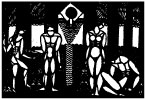The third play of the first bill of the 1917-1918 season was Night by James Oppenheim, a poetic piece for five actors. James Oppenheim was not an active member of the Players, but he was known to them and most in the literary community as the editor of the literary magazine The Seven Arts, which began publishing just a year before in November 1916. This magazine published the works of many literary greats, including Amy Lowell, Sherwood Anderson, Theodore Dreiser, S. N. Behrman, John Dos Passos, and H. L. Mencken, and its advisory board included Kahlil Gibran and Robert Frost. The Seven Arts was forced to stop publication in October 1917, however, when Aileen Rankine, its financial backer, stopped her support because of the magazine’s editorial position of attacking U.S. participation in the war. This turn of events caused Oppenheim to turn to psychoanalysis, and he was particularly drawn to the theories of Carl Jung, writing three books about the topic between 1917 and 1928. Oppenheim’s own prose and poetry has not been considered great by literary critics, his poetry typically labeled as imagist style and often Whitmanesque, though this was not a reference to its quality. The themes in his works often portrayed “the heroic struggle of the foreign born and the poor to achieve a place of dignity in American culture, to make the American dream a reality.”(1) He had written one other play before Night, titled The Pioneers: A Poetic Drama in 1910.
Night is an esoteric, poetic, and symbolic drama, subtitled “A Dramatic Poem,” that begins with three figures: The Priest, The Scientist, and The Poet, who “appear in silhouette before a lighted blue screen upon a simple mound that suggests a hilltop.”(2) After The Priest quotes from biblical scripture, it causes the other two to respond in kind from their own philosophical paradigms of life. Their espousing is interrupted by a woman who is carrying a dead child, her “burden,” and she asks them blatantly “Who has the secret of life among you?” Each tells her his point of view, each trying to explain the death of her son, but she concludes “that no one knows, and no one helps, and life is a madness and a horror, and to be dead is better than to suffer.” As she begins to exit, The Man enters, asking why she has fled, and reminding her that the child was his, too. When she tells that she plans to “follow this child,” i.e. to kill herself, he responds “Then I lose my child . . . even as you lost yours,” and stops her from exiting.(3) When he confesses his need for her, allowing his tears to flow, she declares “This man is my child . . .” and he draws her to him and they exit together, vowing to have no more children and leave to go “down to the living.”(4)
The play ends with each of the three speaking a final line that shows they have remained where they began:
The Priest: Forgive these children, Lord God!
The Scientist: Ignorance is indeed bliss!
The Poet: The secret of life? He gives it to her, she gives it to him . . . But who shall tell of it? Who shall know it? (5)
Rauh performs in a second major role in the same bill as The Woman, clearly ignoring the policy adopted at the end of the previous season. The more experienced and stronger male actors of the company were cast in four of the other roles, with Justus Sheffield as The Scientist, Cook as The Poet, and Hutchinson Collins as The Priest, each of these also playing roles in one of the earlier plays of the bill. Newcomer Rollo Peters was cast as The Man and also designed the set; he received the only critical mention of the actors when Block wrote that he “seemed most satisfactory of the players in the role of the man,” and mentions he is credited with the set design, though it sounds as if he just accomplished what Oppenheim wrote in his stage directions. There is no director listed for the play, which makes one wonder what Moise’s role might have been (she certainly was busy with the other two plays) and if Oppenheim directed his own play. This is possible since the staging requirements were very minimal. The script most certainly must have been a challenge of memorization for the cast as it was more dense with words than most of the plays, and the style required was poetic, though not in verse or rhyme. Block wrote that the play was an “interesting experiment in presentation, although it may be questioned if so many philosophies aid or hinder the delivery of the dramatic content.” He comments that the poem “is not without beauty and force” but “poetry on the stage always intrudes the problem of the medium” and that it “seems to lack some quality the stage must have—to possess some excess of appeal to a vision that is purely cerebral, and to a hearing whose rhythms are only somewhere within the mind.”(6) The Boston Evening Transcript wrote “The self-conscious poetry of the writing robs the piece of any dramatic strength and the ‘silhouette production’ is most clumsily managed. But failure in experiment is one of the virtues of these small playhouses.”(7)
© Jeff Kennedy 2007.
(1) Charles Hackenberry, Dictionary of Literary Biography, Vol. 28: Twentieth Century American-Jewish Fiction Writers. ed by Daniel Walden. (Detroit : Gale Research Co 1984) 203-207.
(2) James Oppenheim, “Night,” The Provincetown Players, ed. Barbara Ozielbo (Sheffield, England: Sheffield Academic Press, 1994) 155.
(3) Oppenheim, Night 163.
(4) Oppenheim, Night 164.
(5) Oppenheim, Night 165.
(6) Ralph Block, “The Provincetown Players Reopen in Macdougal Street.” New York Tribune, 3 November 1917: 13
(7) Boston Evening Transcript, 8 Nov. 1917.
